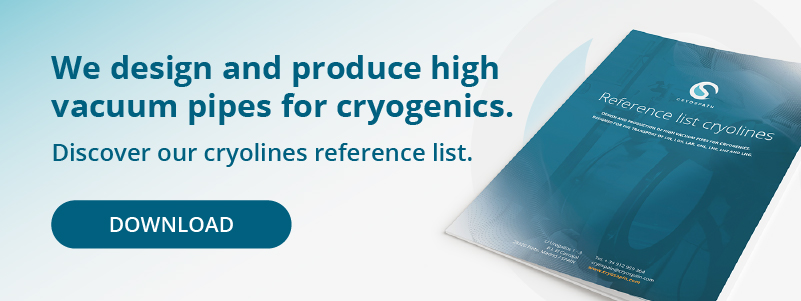Vacuum insulated pipes remain the most efficient equipment in order to ensure cryogenic substances can be safely and efficiently transported without incurring in heat losses and quality reductions.
Used in a wide range of applications, let’s analyze why a vacuum insulated pipe installation can become the best option for companies looking to make their processes more efficient and how to have access to high-quality equipment.
Why vacuum insulated pipes achieve maximum efficiency?
Vacuum insulated pipes consist of the following:
- An inner pipe
- An outer pipe
- A vacuum space between both pipes, achieved through a pump valve and spacers
- Potential additional isolating materials as an outer layer
Through this sort of companies are able to safely transport temperature-sensible substances, such as those that require cryogenic temperature values.
This is because its structure allows for achieving the lowest possible energy loss and minimizing heat leaks, as well as gasification issues, all of which would turn the transportation process into an inefficient and expensive operation.
Multiple industries rely on a cryogenic insulated pipe to guarantee their activities remain efficient, including the food, automotive and marine industries (in increasingly popular bunkering operations) as well as air separation systems.
As more sectors discover the possibilities and advantages of technical gasses and cryogenics, having access to a high-quality vacuum insulated pipe installation remains a top priority.
Advantages of using vacuum insulated pipes
- Minimize heat leaks with proper insulation.
- Preserve cryogenic temperatures and thus the quality of substances.
- Eliminate evaporation issues and gas losses and leaks.
- Minimize excessive vapor and the appearance of ice.
- A much more hygienic structure, avoiding the emergence of moisture and bacterial growth and contamination. They are easily cleaned and also facilitate maintenance processes, even in sectors that are heavily regulated by strict norms, such as the medical and pharmaceutical industries.
- They’re easily produced and transported in separate sections, with the aim of also avoiding issues during its installation.
- As potential gas leaks are minimized, safety increases.
- Economic advantages also arise from having access to an efficient, high-quality vacuum insulated pipe installation.
Related content: The importance of vacuum jacketed piping in industrial plants
Technical Specifications of vacuum insulated pipes
- Used for safely transporting LN2, CO2, LO2, LAr, LNG, LH2, and LHe, among other cryogenic substances.
- Stainless steel is often the most efficient insulating material to avoid heat losses.
- Their components include a process pipe, jacket, vacuum connection, separator, compensator and multilayer.
- Pipe sections can be up to 12 meters long and present diverse diameters (from 1 inch to 10 inches or more), adjusting to each project’s needs
- Their design is guided by directives such as 2014/68/UE, TRCU-032/2013 and ASME.
- Design codes: EN13480 and ASME B31.3.
- Welding and NDT codes: ASME IX/V, UNE-EN y and our own standard for Helium leak tests.
- Class of maritime approval: RINA, Bureau Veritas, DNV y Lloyd’s Register.
- Accessories may include: a vacuum purger, a vacuum-insulated phase separator and a gas trap.
Flexible vacuum insulated transfer pipes VS Rigid vacuum insulated transfer pipes
Vacuum insulated pipes present two formats:
- Rigid pipes are based on two rigid pipes. Assembled using bayonet fittings to avoid heat loss issues and guarantee their junctions are safe and efficient, they’re generally easier to install.
- Flexible or bendable vacuum insulated pipes present a structure of two convoluted pipes (inner and outer), also installed using bayonet connectors. This type of system is usually more economical in terms of transportation to the assembling point and their production, as it avoids costly layout measurements. They typically have a larger diameter and might potentially present higher pressure losses. They remain a more flexible choice in terms of location and can be used to optimize already-existing systems.
Keep reading: Ultra High Vacuum, the ultimate evolution of High Vacuum
Choosing a trusted vacuum insulated pipe supplier
As picking the right vacuum insulated pipe can make a big difference in terms of efficiency and cost savings, choosing the right supplier is also a key decision in this process.
At Cryospain we work to provide vacuum insulated pipes through our Cryoline equipment. Taking care of the whole process, from design to manufacture and installation, we produce all equipment involved in developing a safe and efficient transportation of cryogenic substances, including pipes, purgers, phase separators, and high tech fast cooling systems adapted to the needs of each project.
As such, we’ve been involved in the production of over 7000 meters of vacuum insulated pipe for the transportation of different types of gasses:
> 50 LIN / LOX / LAR projects
> 20 LNG projects
> 5 LHe / LH2 projects
> 7 LNG / LH2 ship conversions
Through following the strictest quality standards and certificates, we carry out the mechanical and thermal design, the manufacturing, and the commissioning of these systems according to each project’s needs and being able to deliver turnkey projects.
Want to know more about these pipes and how they can maximize efficiency in dealing with cryogenic substances? Get in touch with us.











 Contacte-nos
Contacte-nos